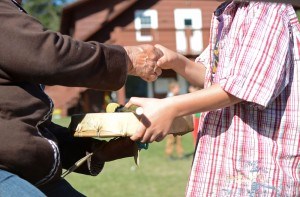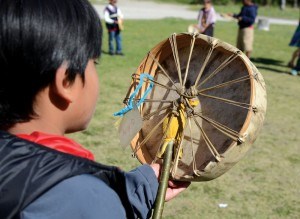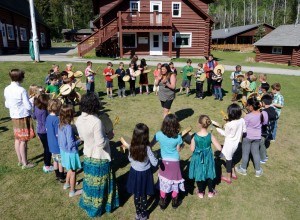
One day last winter, AnneMarie MacDonald walked into her Grade 3 classroom at Jasper Elementary School and found a cardboard box next to her desk. She thought it was her Scholastics order, full of new books for the kids.
“And then I kind of nudged it with my toe and went, ‘Oh! It’s an animal.’
“Only in our world would that happened,” she said with a laugh, speaking of herself and Kathryn Howe, another Grade 3 teacher at the school.
The “animal” wasn’t alive, however. It was a deer hide left by a local hunter.
MacDonald and Howe spent last fall collecting hides—20 in total—so their students could spend the spring building their own Aboriginal drums. The project was part of their annual field school, which takes students out into the community and park for experiential learning opportunities.
This year, the teachers took that learning to a whole new level, using drum making to teach the students about animal lifecycles, sound and music—subjects that are in the Grade 3 curriculum—as well as teaching them about Aboriginal culture, traditions and history.

It was a project months in the making, with a beginning as simple and serendipitous as any other.
While out for a walk, MacDonald passed Ursula Winkler’s house and glimpsed a drying hide in the yard. The sight drew her in and before they knew it, the women had a brilliant idea—a plan to teach all of Jasper Elementary School’s Grade 3 students how to build their own drums.
“We imagined it,” said Winkler, a long time advocate for alternative education, “and then we asked the hunters in the fall if they would bring their hides.”
That request reached far and wide throughout the community, resulting in an onslaught of deliveries, and before the teachers knew it they had moose, deer and elk hides, all of which had to be stored in freezers over the winter.
And, as with seemingly everything for the project, the freezer space was donated.
In the spring, the hides were dried and the kids were invited to Winkler’s house to learn how to clean them. They mixed their own solution of water and ash, soaked the hides and then used tools to scrape away the hair.
That was Grade 3 student Hana Rode’s favourite part.
Why, you might ask?
“Because it was gross,” she said with a grin.
“There was some pungent smell to it, but they were very good,” said Winkler of the students.
Each class cleaned one hide and then Winkler and her husband, Terry, finished the rest. The hides were then dried and stretched in preparation for cutting. Nearly 20 parents gathered together to cut out individual drum heads for each of the students. Those circular pieces were later stretched over wooden frames and laced, along with help from another group of parents who came into the classroom to build the drums with the kids.
“It’s just been a huge sense of community bringing this together,” said Howe.
“And in the greater community, not just the school community,” added MacDonald, noting that as well as the hides, the ash was also donated, as well as hours of time from parents and community members.
There was also financial support from the Grande Yellowhead Public School Board and Servus Credit Union, without which the project would have never happened.
There were also teachings by Matricia Brown, a First Nations drum keeper and educator, who came into the classroom before the students had built their drums to explain the significance of the Aboriginal drum and the honour it is to be a drum keeper.
“We treat our drum like a sister—with that level of respect,” she told the students. “Some people think they can own a drum, but you don’t own it. Your drum has its own personality. It’s its own person.”
Brown also taught the students the proper protocols around drums, as well as the protocols for speaking with an elder. They learned about the significance of tobacco and its use as an offering, as well as about the different plants that are used during a smudging ceremony.
And throughout they learned that building a drum isn’t a craft, it’s an honour.
“I’m hoping that we’re changing cultural prejudice by having them be part of a process that’s really sacred and special, and that they’ll now have something that they can share with First Nations, Metis and Inuit people,” said Howe.

The project culminated last week with a blessing ceremony at the Palisades Stewardship Education Centre.
There, the students met Dorothy Courtereille, an elder from Hinton. She blessed each of the drums, passing them through the smoke of burning sage—the sacred medicine for women.
“She’s blessing it to the four different directions,” explained Brown, pointing out the way Courtereille moved the drum from one side to the other before giving the drum back to the students along with a drum stick made by the Winklers.
“Take care of your drum and treat it with respect,” said Courtereille as she shook the hand of each of the students.
Prior to the blessing, the students were not allowed to play their drums. Howe said, although it took some strength to resist the urge, by the time the drums were built, the students had such a great respect for what it means to be a drum
keeper that they used restraint.
And on May 21, the students were rewarded for their strength, receiving their very own drum sticks and finally learning to drum.
Gathered in a circle, Brown stood in the middle, singing and providing the students with direction. As they tested out the sound of their handmade creations, she told them not to politely drum, but to play the drum with meaning.
“We don’t want to beat it. We don’t want to strike it. But we do want to play it with intention,” she explained, showing the students how to straight drum and side drum.
“There was a few moments where they were drumming together,” said Brown, as she was reflecting on the day. “You could feel the vibrations.
“The kids will remember this for their entire lives.”
With their drums stretched, laced, tied, oiled and blessed, the students will now write their own drum song that they’ll play for everyone who contributed to their field school experience, whether that be the hunters or the community members that provided ash or the parents who lent a hand.
Howe said there isn’t yet a date for that drum circle, but that the students will also be learning some traditional songs from Brown.
Looking back on the process, Howe said it far exceeded her expectations.
“But it’s not the end of the road,” she said.
Nicole Veerman
[email protected]
